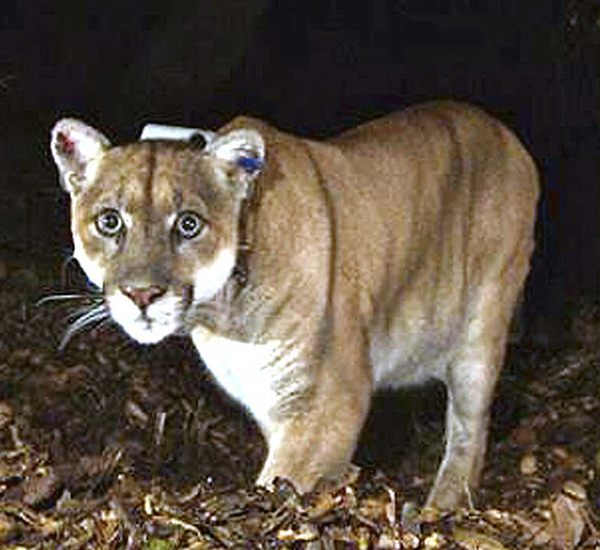Wave Staff and Wire Reports
GRIFFITH PARK — A “celebration of life” for famed Southland mountain lion P-22 will be held at the Greek Theatre in February, honoring the cat who made Griffith Park his home and became the face of the endangered Southern California lion population.
The free event is scheduled for noon on Feb. 4, according to the theater’s website. Tickets will be required, but details about their distribution have not yet been announced.
The lion was euthanized Dec. 17 after being examined by wildlife officials who captured the cat following recent signs of distress, including a series of attacks on pet dogs in the area.
“We will all be grappling with the loss for some time, trying to make sense of a Los Angeles without this magnificent wild creature,” a message on the theater’s website said. “Let’s come together as a community to celebrate his remarkable life. Joining us will be special guests speaking about their connections to P-22 — and how he also connected us all.”
The two-hour event is expected to include musical performances, dancing and food, according to the theater. More information is expected to be released in coming days through the theater and at www.savelacougers.org.
The big cat’s well-chronicled life as a solitary male marooned in eight square miles of Griffith Park helped galvanize interest in urban wildlife and spur city dwellers to be advocates for habitat conservation.
The California Department of Fish and Wildlife, along with wildlife biologists with the National Park Service, made the decision to euthanize P-22 due to the severity of the injuries he suffered after being hit by a car earlier this month.
He was captured and tranquilized out of concern for his well-being due to his advanced age, declining health and recent attacks on pets in residential areas, which suggested the mountain lion was in distress. After being examined by wildlife experts, it was determined that he was malnourished, suffering from mange, and had extreme trauma to one eye, possibly from contact with a motor vehicle.
The remains of P-22 were brought to the Natural History Museum from the San Diego Zoo Safari Park Dec. 23. He was transported by Miguel Ordeñana, senior manager of community science, Assistant Curator of Mammalogy Kayce Bell, and descendents from Gabrieleño/Tongva, Tataviam and Chumash Native Americans tribes. They were joined at the museum by descendants from Gabrielino-Shoshone, Akimel O’otham and Luiseño tribes.
Upon arriving at the museum, tribal representatives led a blessing ceremony welcoming P-22 back to his homeland. Decisions regarding next steps will continue to be made together with local tribes, with more information provided as it becomes available, the museum said in a statement posted on its website.
“On behalf of everyone at [the museum], we are very saddened by the loss of P-22, an iconic ambassador for wildlife in Los Angeles,” Ordeñana said. “His passing is a painful moment, but we are so thankful for how he created a better understanding of the coexistence of urban wildlife, humans and L.A.’s biodiversity.
“His story is a catalyst for change, inspiring conservation efforts, including the 101 freeway wildlife crossing and much more. Even in his death, P-22 continues to inspire L.A. to embrace urban wildlife conservation and the nature that surrounds us. [The museum] will continue to share his story and honor and preserve his legacy for generations to come.”
Ordeñana said he hopes P-22’s legacy will provide all communities, including those historically excluded from nature, with a sense of pride within the field of wildlife conservation.
P-22 was first spotted in 2012 by Ordeñana as part of the Griffith Park Connectivity Study, a joint effort of Friends of Griffith Park, Cooper Ecological Monitoring and the U.S. Geological Survey. For the study, Ordeñana had set camera traps (motion-activated cameras) to document wide-ranging wildlife in the park and on potential corridors as a way to document connectivity between Griffith Park and neighboring open spaces.
Ordeñana was thrilled to discover an image of a mountain lion, whose presence in the area had previously not been officially verified. Discovering a mountain lion in Griffith Park confirmed for scientists the park’s role as a haven for wildlife that is more connected to nearby open spaces than previously thought.
Not only did P-22 inspire podcasts, news articles, and a devoted fan club, he was the subject of scientific research and a catalyst for environmental initiatives. A first-ever video of P-22 vocalizing supports cutting-edge research suggesting that mountain lion communication is more complex than once thought.
His plight also helped inspire the development of the Wallis Annenberg Liberty Canyon Wildlife Crossing, destined to be the biggest such corridor in the world.
The museum will continue to celebrate P-22’s life through an exhibit, “The Story of P-22, L.A.’s Most Famous Feline,” a permanent exhibit which opened in 2017 and documents the big cat’s journey through graphics, projections, photography and video.
The exhibition includes footage of the cougar being collared and moving through his territory at night, and explores survival challenges that he and all of Southern California’s mountain lions face living in L.A.’s backyard.
Local Native American tribal leaders — who consider cougars to be sacred — have objected to a suggestion that the lion be placed on display at the museum, arguing instead that he be buried in Griffith Park with a ceremony that honors his spirit.












